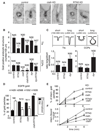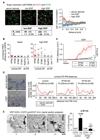Reticulon 3-dependent ER-PM contact sites control EGFR nonclathrin endocytosis
- PMID: 28495747
- PMCID: PMC5432029
- DOI: 10.1126/science.aah6152
Reticulon 3-dependent ER-PM contact sites control EGFR nonclathrin endocytosis
Abstract
The integration of endocytic routes is critical to regulate receptor signaling. A nonclathrin endocytic (NCE) pathway of the epidermal growth factor receptor (EGFR) is activated at high ligand concentrations and targets receptors to degradation, attenuating signaling. Here we performed an unbiased molecular characterization of EGFR-NCE. We identified NCE-specific regulators, including the endoplasmic reticulum (ER)-resident protein reticulon 3 (RTN3) and a specific cargo, CD147. RTN3 was critical for EGFR/CD147-NCE, promoting the creation of plasma membrane (PM)-ER contact sites that were required for the formation and/or maturation of NCE invaginations. Ca2+ release at these sites, triggered by inositol 1,4,5-trisphosphate (IP3)-dependent activation of ER Ca2+ channels, was needed for the completion of EGFR internalization. Thus, we identified a mechanism of EGFR endocytosis that relies on ER-PM contact sites and local Ca2+ signaling.
Copyright © 2017, American Association for the Advancement of Science.
Figures






Comment in
-
Keeping in touch with the ER network.Science. 2017 May 12;356(6338):584-585. doi: 10.1126/science.aan4807. Science. 2017. PMID: 28495716 Free PMC article. No abstract available.
-
Endocytosis: Remote Control from Deep Inside.Curr Biol. 2017 Jul 10;27(13):R663-R666. doi: 10.1016/j.cub.2017.05.018. Curr Biol. 2017. PMID: 28697369
References
-
- Johannes L, Parton RG, Bassereau P, Mayor S. Building endocytic pits without clathrin. Nat Rev Mol Cell Biol. 2015 May;16:311. - PubMed
-
- Boucrot E, et al. Endophilin marks and controls a clathrin-independent endocytic pathway. Nature. 2015 Jan 22;517:460. - PubMed
-
- Lund KA, Opresko LK, Starbuck C, Walsh BJ, Wiley HS. Quantitative analysis of the endocytic system involved in hormone-induced receptor internalization. J Biol Chem. 1990 Sep 15;265:15713. - PubMed
Publication types
MeSH terms
Substances
Grants and funding
LinkOut - more resources
Full Text Sources
Other Literature Sources
Molecular Biology Databases
Research Materials
Miscellaneous

